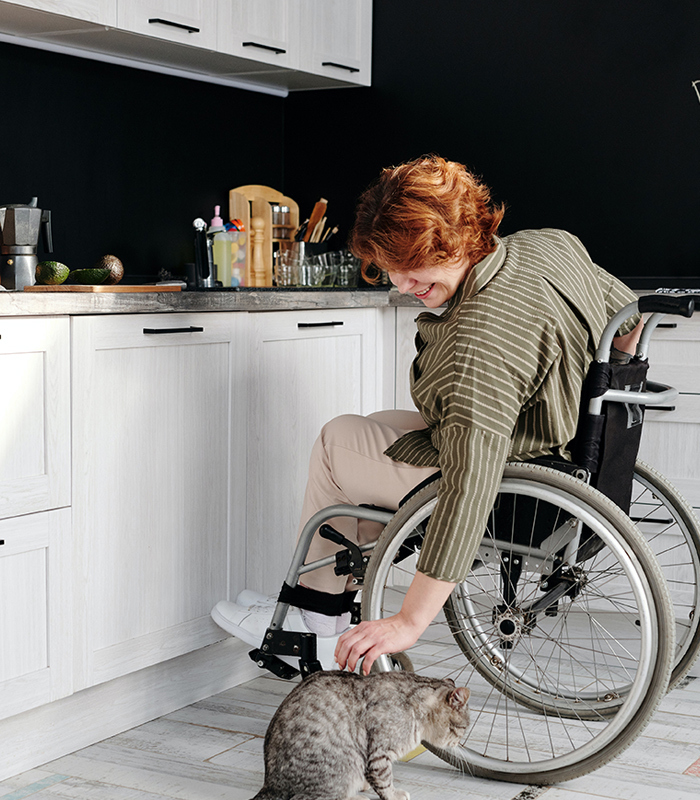Accessible Homes Week is a chance for those within the built environment to recognise how essential accessible design can help to transform a person’s life for the better. It’s also a chance to examine approaches and current attitudes to the discipline within the profession, and to raise awareness – what does accessible design mean, and how can you, well, access it?
Within the conversation about accessible design, Amy Francis-Smith, an architect and accessibility expert, thinks fellow architects also need to be aware of a much less debated concern: the changing needs of occupiers over time that could be met through thoughtfully-designed, adapted housing.
This could mean adaptations that cater to the needs of an ageing population (whose needs change over a longer time period), while also taking into consideration those whose situations have changed dramatically in a relatively short space of time (perhaps due to unforeseen illness or mobility challenges after an operation).

What are the statistics of disabled and older people living in unsuitable housing?
With around 9% of the housing stock in England having basic access features, it is accepted that far too many with additional health needs and older people, are living in unsuitable housing, which is impacting on their ability to live well independently.
It is also estimated that about one-in-five people live with a disability that means they may benefit from adaptations to their existing homes. This clearly shows the scale of work that must be undertaken to increase accessibility across existing and new housing stock.
Read more with RIBA’s Inclusive Design Overlay to the Plan of Work.
“This is a much bigger issue than most people realise,” says Amy Francis-Smith. “Existing accessible housing is a hidden housing crisis that most people are not really aware of unless it hits them personally and they suddenly find that they need to spend thousands of pounds after a crisis or a sudden health issue arises.”
There is a lot of guidance on the progressive needs of ageing occupiers, dealing with stairs and bathrooms, mobility issues and declining dexterity. But shorter term events can leave people feeling like prisoners in their own homes, and almost losing their sense of independence overnight.
How can architects help to make home more accessible?
One all-too-common scenario, which Amy has seen up close for herself, is an occupier’s application to their local authority for a Disabled Facilities Grant. This grant, which can allow disabled residents to make necessary changes to their homes, results in a local authority sending around a company to carry out an assessment.
These assessments can focus on the immediate needs of the individual, Amy explains, while ignoring the wider impact on family and carers in the household, not to mention longer-term adaptability measures that might be required further down the line.
Setting up a bedroom or a modular bathroom in ground floor living spaces, for instance, can have a negative impact on the space in a home and leave other family members completely adrift and retreating to their bedrooms, says Amy. Proud residents can see these changes as tragedies in themselves.
In contrast, an architect can work with the individual and the family – perhaps alongside an occupational therapist if an ergonomic assessment and solution is required – and take a more holistic approach to the whole house or apartment.
There are usually more considered solutions available to mobility issues than tacking on an extension, for instance, such as inserting a structural element that will allow the installation of a lift.
Read more with Julie Fleck’s Are You An Inclusive Designer?
There is also no reason why architects cannot produce beautiful design solutions to problems, Amy adds, and source fixtures and fittings that avoid the institutional-looking grab rails and obvious mobility aids that may work but which may not fit with the tastes and preferences of occupants.
With all that being said, Amy believes that there is an extensive demand for architectural solutions for adapted housing that is not being voiced.
A strong property investment case can be made for carefully considered, adapted homes, she points out, as there is always a shortage of well-designed properties in a surprisingly scarce sub-sector of the market. However, Amy also adds that if carried out poorly, bad design can also devalue a property.

What guidance on accessible design is available to architects?
There is a large amount of guidance that architects can draw upon for the adaptation of existing homes.
For mobility and accessibility, the key document for designers used to be the Lifetime Homes Standard, which was technically authored and supported by Habinteg, the housing association host of Accessible Homes Week.
Following the government’s Housing Standards Review in 2015, the ‘accessible and adaptable dwellings’ standard in Lifetime Homes was adopted as the optional Building Regulations standard M4(2). The standard for wheelchair accessible homes was adopted as the optional M4(3).
However, despite a commitment to make M4(2) mandatory for new homes and conversions - with a follow-up consultation in implementation planned - the government still shows no sign of taking steps to implement the policy, much to the frustration of many in the accessible design community. M4(2) can be required as a planning condition by local planning authorities, and was made mandatory by the Greater London Authority in 2015. Generally speaking, this is only required via the S106 obligations for the affordable homes provision on developments.
In addition to Building Regulations, Amy recommends architects look at BS8300 for comprehensive guidance on accessibility, and the guidance on design for neurodiversity available from the University of Stirling, which is an international hub for knowledge exchange and research dedicated to improving the lives of people living with dementia.
She offers the following as a list of resources:
- Approved Document Part M – Also Parts B & K are relevant to disabled people.
- BS 8300 1 & 2 – Design of Buildings: Disabled People
- The Access Audit Handbook – Centre for Accessible Environments
- Housing LIN (Multiple Design Resources & Research – Care Homes, Older People, Housing, Specialist Needs etc.)
- Dementia – Dementia Services Development Centre (DSDC) at University of Stirling
- Vision Impairment – RNIB
- BSI Design for the Mind – Neurodiversity and the Built Environment (PAS 6463)
Thanks to Amy Francis-Smith, architect and accessibility expert.
Text by Neal Morris. This is a Professional Feature edited by the RIBA Practice team. Send us your feedback and ideas.
RIBA Core Curriculum topic: Inclusive environments.
As part of the flexible RIBA CPD programme, professional features count as microlearning. See further information on the updated RIBA CPD core curriculum and on fulfilling your CPD requirements as a RIBA Chartered Member.









